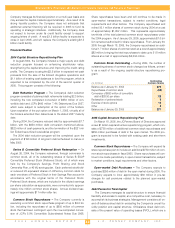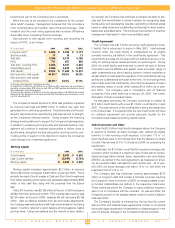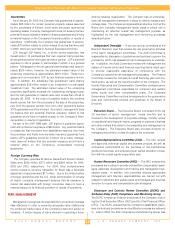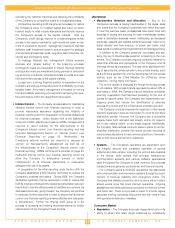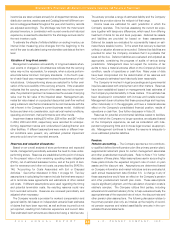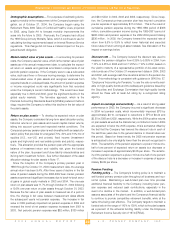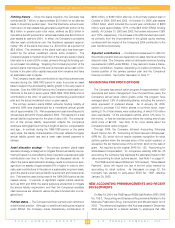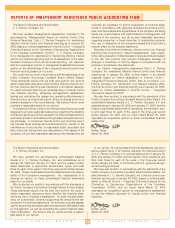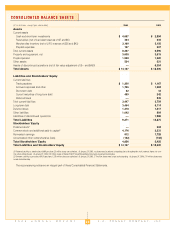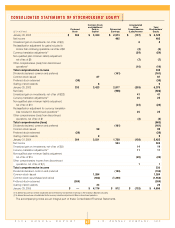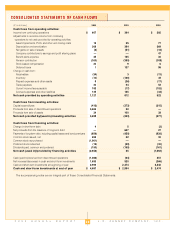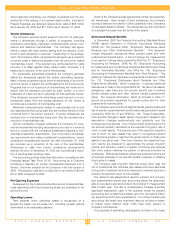JCPenney 2004 Annual Report Download - page 23
Download and view the complete annual report
Please find page 23 of the 2004 JCPenney annual report below. You can navigate through the pages in the report by either clicking on the pages listed below, or by using the keyword search tool below to find specific information within the annual report.
J.C. PENNEY COMPANY, INC.2 004 ANNUAL REPORT
Management’s Discussion and Analysis of Financial Condition and Results of Operations
21
Funding history
— Since the plan’s inception, the Company has
contributed $1.7 billion, or approximately $1.0 billion on an after-tax
basis, to its primary pension plan. Over this timeframe, actual invest-
ment return on plan assets has generated a significant portion of the
$6.5 billion in pension plan total value, defined as $2.5 billion in
cumulative benefit payments to retired associates plus $4.0 billion in
plan assets at year-end 2004. In effect, the Company’s cumulative
after-tax cash contributions over this timeframe represent approxi-
mately 15% of the plan’s total value (i.e., $1.0 billion as a percent of
$6.5 billion). The remainder of the plan’s total value has been gen-
erated by the actual investment returns since inception. The
Company targets to maintain its portion of the primary pension plan’s
total value to a level of 20% or less, primarily through its funding pol-
icy and asset mix strategy. Targeting the Company’s portion of the
pension plan’s total value at this level is important since cash contri-
butions to the plan utilize capital resources from investors and have
an associated cost of capital.
The Company made cash contributions to its primary pension plan
annually during the 1966-1983 period in order to provide an asset
base to support the accelerating liability growth in the early years of
the plan. Over the 1984-2004 period, the Company made cash con-
tributions to the plan in seven years (1993-1996, 2002-2004) and no
contributions in the other 14 years due to maintaining a well-funded
plan and the actual investment return on plan assets.
The primary pension plan’s ERISA actuarial funding liability at
year-end 2004 was characterized by a normalized annual growth
rate of approximately 3%. Plan expenses and cash benefits paid to
retirees were about 6% of plan assets in 2004. This resulted in a total
annual liability requirement for the plan of about 9%. The composi-
tion of this annual liability requirement reflects the Company’s
employee demographics in terms of length of service, compensation
and age. In contrast, during the 1966-1983 period, or the plan’s
early years, the liability characteristics of the plan reflected a higher
annual liability growth rate and a lower cash benefit payment to
retirees.
Asset allocation strategy
— The primary pension plan’s asset
allocation strategy is designed to mitigate this annual liability require-
ment and result in a cost-effective level of pension expense and cash
contributions over time to the Company as discussed above. In
effect, the plan’s asset allocation strategy needs to produce an aver-
age return on assets of approximately 9% or higher in order to elim-
inate cash contributions to the plan on a sustainable long-term basis,
given the plan’s current annual liability requirement and funded posi-
tion. This was the case during most of the 1984-2004 period as dis-
cussed above. In periods of significant capital market declines,
such as 2001 and 2002, the plan’s surplus is utilized first to mitigate
the annual liability requirement, and then the Company’s available
cash resources are utilized to restore the plan’s funded ratio to a tar-
geted level.
Funded status
— The Company’s primary pension plan remains in
awell-funded position. Although no additional funding was required
under ERISA, the Company made discretionary contributions of
$300 million, or $190 million after tax, to its primary pension plan in
October of 2004, 2003 and 2002. At October 31, 2004, plan assets
of $4.0 billion, which included the current year contribution of $300
million, were approximately 137% of the $2.9 billion ERISA funding
liability. At October 31, 2003 and 2002, the funded ratios were 129%
and 112%, respectively. The increase in the 2004 funded ratio result-
ed primarily from the improvements in the global equity markets,
combined with the impact of the Company’s 2004 contribution to the
plan mentioned previously.
Expected contributions
— Contributions subsequent to 2004 for
the primary pension plan are dependent on asset returns and future
discount rates. The Company does not anticipate minimum funding
requirements in 2005 under ERISA. It may decide to make a discre-
tionary contribution, however, depending on market conditions, the
funded position of the primary pension plan and the Company’s
financial condition. See further discussion in Note 17.
ACCOUNTING FOR STOCK OPTIONS
The Company has a stock option program for approximately 1,600
executives and senior management. Over the past three years, the
Company’s annual stock option grants under this program have
averaged about 1.6% of outstanding shares, including the common
stock equivalent of preferred shares. As of January 29, 2005,
options to purchase 13.8 million shares of common stock, repre-
senting 5.1% of total shares, were outstanding, of which 10.8 million
were exercisable. Of the exercisable options, about 72% were “in-
the-money,” or had an exercise price below the closing end-of-year
stock price of $41.69. See Note 15 for more details about the
Company's stock option program.
Through 2004, the Company followed Accounting Principles
Board Opinion No. 25, “Accounting for Stock Issued to Employees”
(APB No. 25), which did not require expense recognition for stock
options granted when the exercise price of the option equaled, or
exceeded, the fair market value of the common stock on the date of
grant. As required by the original SFAS No. 123, “Accounting for
Stock-Based Compensation,” for companies retaining APB No. 25
accounting, the Company has disclosed the estimated impact of fair
value accounting for stock options issued. See Note 1 on page 31.
The FASB recently issued Statement 123 (revised), “Share-Based
Payment,” which will require the use of the fair value method for
accounting for stock options. As discussed on page 22, the
Company has elected to early-adopt SFAS No. 123R, effective
January 30, 2005.
NEW ACCOUNTING PRONOUNCEMENTS AND RECENT
DEVELOPMENTS
On May 19, 2004, the FASB issued FASB Staff Position (FSP) SFAS
No. 106-2, “Accounting and Disclosure Requirements Related to the
Medicare Prescription Drug, Improvement and Modernization Act of
2003.” The referenced legislation (the Act) was passed in December
2003 and provides for a federal subsidy to employers that offer



